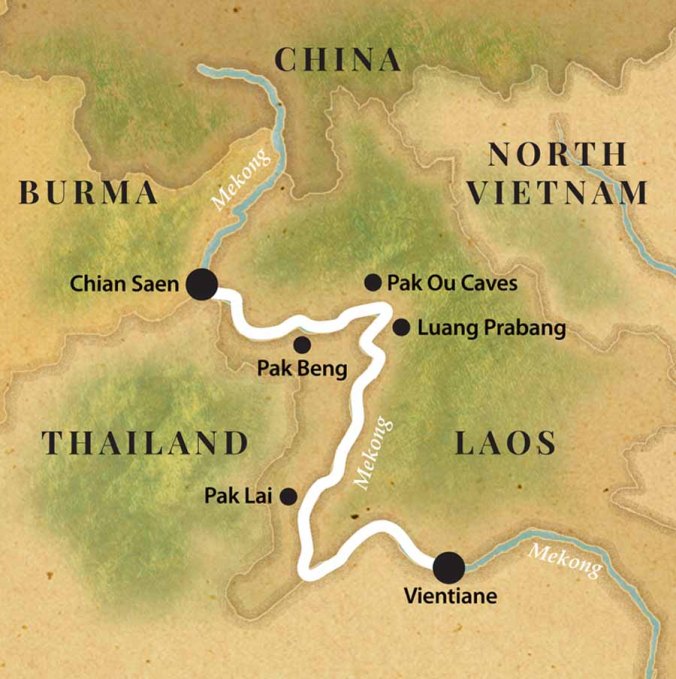 This was part of a holiday we had recently in Laos. The first ten days were travelling up the Mekong River from Vientiane, the capital of Laos to Chian Saen and the “Golden Triangle” where Thailand, Myanmar (Burma) and Laos come together.
This was part of a holiday we had recently in Laos. The first ten days were travelling up the Mekong River from Vientiane, the capital of Laos to Chian Saen and the “Golden Triangle” where Thailand, Myanmar (Burma) and Laos come together.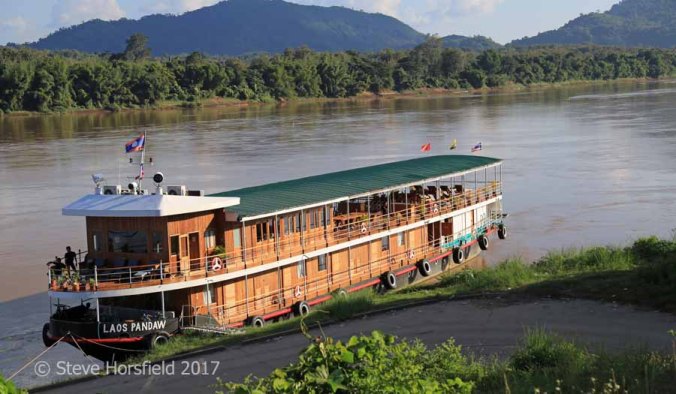 We were travelling on the RV Laos Pandaw one of specially-designed luxury small ships for exploring remote and often hard-to-navigate rivers. Each ship, hand-crafted in brass and teak, is an object of beauty in itself. The ships are small scale, and the atmosphere is informal, and very friendly. On our trip there were a total of 15 guests although there could have been up to 20. See here for more information on Pandaw.
We were travelling on the RV Laos Pandaw one of specially-designed luxury small ships for exploring remote and often hard-to-navigate rivers. Each ship, hand-crafted in brass and teak, is an object of beauty in itself. The ships are small scale, and the atmosphere is informal, and very friendly. On our trip there were a total of 15 guests although there could have been up to 20. See here for more information on Pandaw.
Vientiane, Laos’ national capital, mixes French-colonial architecture with Buddhist temples such as the golden, 16th-century Pha That Luang, which is a national symbol. Along broad boulevards and tree-lined streets are many notable shrines including Wat Si Saket, which features thousands of Buddha images, and Wat Si Muang, built atop a Hindu shrine.

Pha Thad Luang

Pha Thad Luang

Wat Sisaket

Hor Pra Keo

Pha Tu Xai monument

Wat Sisaket

Hor Pra Keo

Wat Sisaket
The distance we traveled up the river was 900 kilometers. For much of the journey there is a panorama of mountains with the jungle coming down to the river.
Parts of the river is wide and relatively slow whereas other parts have
rapids which need to be negotiated with some care.
The boat stops a couple of times each day for us to go ashore.  Typically this would be to a small Laotian village or to an ethnic village. There are 49 officially recognized ethnic minorities in Laos representing four
Typically this would be to a small Laotian village or to an ethnic village. There are 49 officially recognized ethnic minorities in Laos representing four
ethno-linguistic families: Tai-Kadai, Mon-Khmer, Hmong-Mien and TibetoBurman.
These in turn all have many branches and sub-groups. Many of these ethnic groups are very poor living barely at a subsistence level.
The Laotian village called Ban Muangnuea

Vegetable garden

Vegetable garden

Village rush hour

Village school

School children
were each house has an area growing greens etc. This village was the most prosperous one we visited.
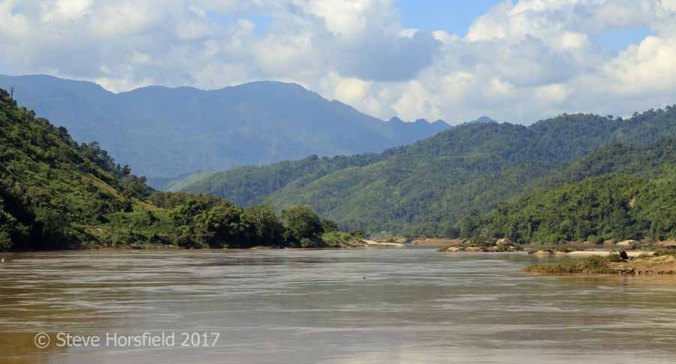
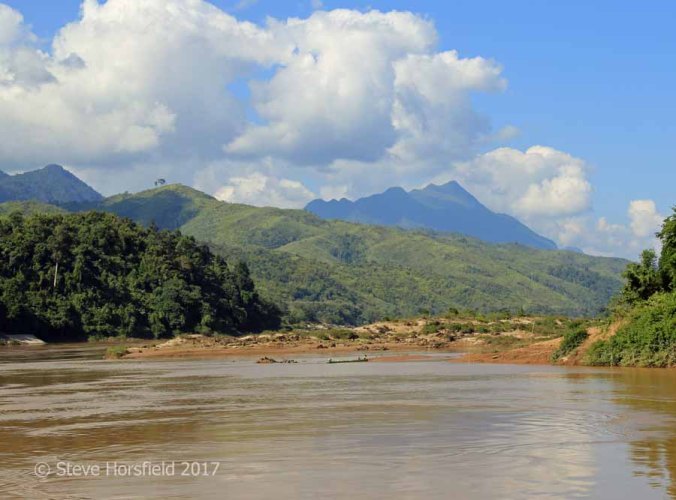
The next stop Ban Pak Lo a Khamo tribal village
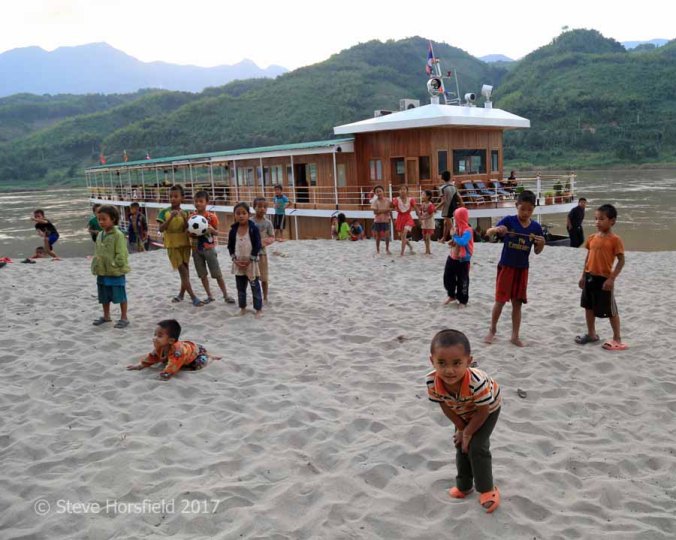 The children always come out to meet the boat whenever it stopped.
The children always come out to meet the boat whenever it stopped.

Preparing supper

Hydro electricity
A very poor village. Their electricity is provided by the dynamo hung into the waterfall. Enough for a small light and to recharge a mobile phone.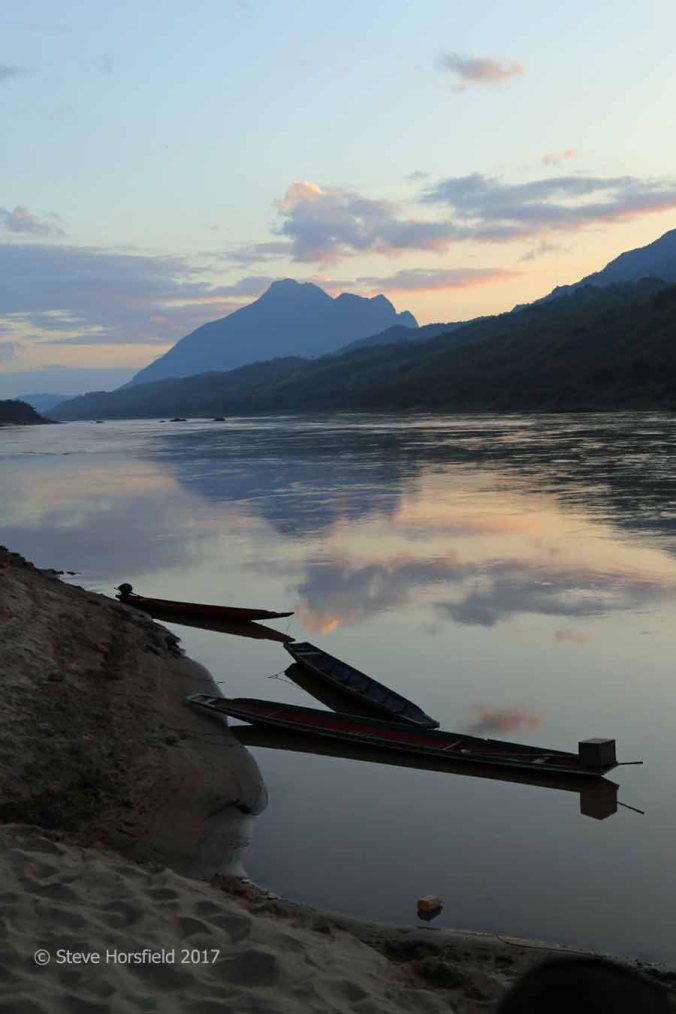
The Mekong River is changing rapidly with Chinese and Thai investments happening every where.

The out run from the dam

Entrance to the lock

The lock

Lock gates

First set of lockgates opening prior to the second lock

Workers at the lock watching one of the few boats go through
We passed through the Xayabori Hydroelectric Dam which is being constructed by the Thai government with 95% of the electricity going to Thailand.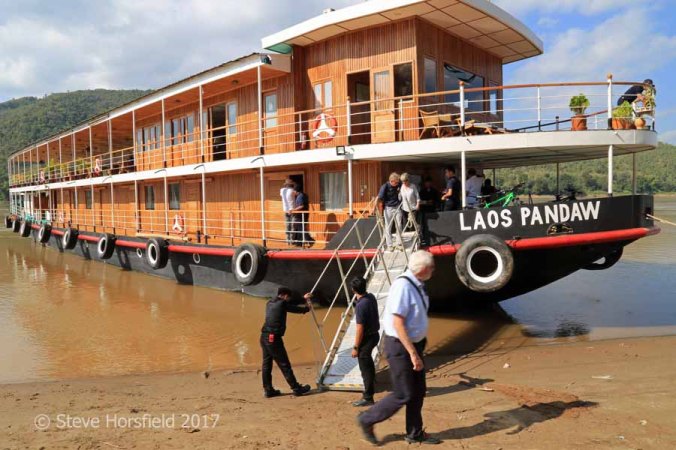 Ashore again to visit the Khaung Si waterfalls and a butterfly garden.
Ashore again to visit the Khaung Si waterfalls and a butterfly garden.

Khaung Si waterfall

Khaung Si waterfall

Water in the butterfly garden
We then arrived at Luang Prabang, the ancient capital of Luang Prabang Province in northern Laos, lies in a valley at the confluence of the Mekong and Nam Khan rivers. Inhabited for thousands of years, it was the royal capital of the country until 1975. It’s known for its many Buddhist temples, including the gilded Wat Xieng Thong, dating to the 16th century, and Wat Mai, once the residence of the head of Laotian Buddhism. This is a beautiful town which was designated a UNESCO World Heritage Site in 1995 and the centre of the town is endowed with a legacy old ancient red-roofed temples and french-Indochinese architecture.

Wat Xieng Thong

Luang Prabang Street scene

Wat Xieng Thong

Wat Mai

Wat Mai ceremonial boat

Luang Prabang Street scene

Wat Mai

Wat Xieng Thong

Wat Xieng Thong

Wat Saen

Wat Xieng Thong

Wat Xieng Thong

Wat Xieng Thong
Each morning at dawn there is a alms giving ceremony called Tak Bat when processions of saffron robed monks carry baskets into which locals (and some tourists) place sticky rice. There are strict guidelines on how to behave if you join this ceremony and the Pandaw team ensured we did it correctly.

Baskets of sticky rice

Monks receiving Tak Bat

Monks processing in the Tak Nak ceremony
The night market was disappointing as most of the stuff on sale had clearly been mass produced, probably in China. However, as often is the case in south east asia the food market was great.

Night Market

Night Market

Frogs

Beatles

Catfish

Remains of a Monitor Lizard
Baci Ceremony is specific ceremony in Laos which has been practiced for hundreds of years. The purpose of this Laotian ceremony is to to call escaped spirits back to the body, an animist tradition that is very important for Lao people before major events such as weddings, births, travel or when welcoming friends, to bring good luck. The ceremony involves the tying of white cotton strings around person’s wrists and the prayer saying or well wishing for the person that the ceremony is intended for. This ceremony was followed by Lao traditional dance.

Baci ceremony

white cotton strings around wrist

Baci ceremony

Lao traditional dance

Lao traditional dance
The facilities on the RV Laos Pandaw are first class. From morning coffee to the cocktail hour and dinner the service was impossible to fault.

Starters and deserts

Cheese board

Starters and deserts

Dining area

Lounge and bar

Lounge and bar

RV Laos Pandaw
Local people collecting sand from the river for construction.
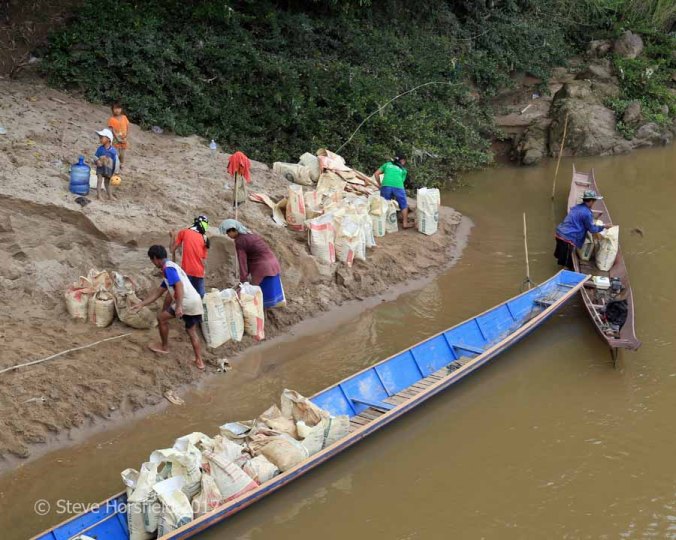
The Pak Ou Caves, a Buddhist sanctuary and an elephant camp

Elephant camp

Pak Ou Caves
Many of the villages we visited are very poor and we wanted to do our bit to help. Our excellent guide, called Bee, suggested that in a particular village they needed shoes for the children and blankets to keep warm at night. We made a collection and Bee and the Pandaw team sourced the shoes and blankets. The village was called Ban Pak Sith

Ban Paksith village

The Pandaw crew with some of the blankets

The children

The village water buffalo

Bee trying to organise the children into rows

Bee with the children and their new shoes

The next stop was in Pak Beng, one of those places that only exists because it is half way between the Golden Triangle and Luang Prabang. As such when we where there in the middle of the day it was more or less deserted. The village is full of hostels etc for boats to overnight when the place gets full of people. We needed to stop in order to do some formalities for our boat. However, the most interesting thing were the vegetable gardens (see photographs below) which provided produce for the many hostels and restaurants.

Pack Beng

Pack Beng
Another stop, this time a Lao Lum village.

RV Laos Pandaw

Village children coming to meet the boat

Crew ensuring the gang plank is fixed

Crew creating a staircase for us to walk up!

Village children

Th village shop
Finally we arrived at Huay Xai and the “Golden Triangle”

Sop Ruak

Auto taxi meeting the boat to take us around Sop Ruak

Buddha statue next to the Mekong river

Thailand on the left, Myanmar in the middle and Laos on the right

last night more traditional dancing
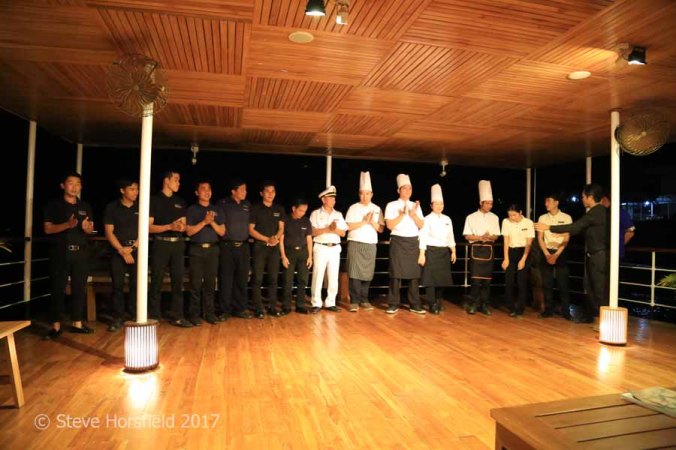 And said our good byes to the crew of the boat with many great memories of the Mekong River.
And said our good byes to the crew of the boat with many great memories of the Mekong River.
 Another frosty morning but at last all the roses on the wall have all been pruned. It has been slow work with a week of snow on the ground and at least another week of rain.
Another frosty morning but at last all the roses on the wall have all been pruned. It has been slow work with a week of snow on the ground and at least another week of rain.  There are a few roses that still need sorting out. A bit late but I am sure they will survive.
There are a few roses that still need sorting out. A bit late but I am sure they will survive.  The weather certainly resulted in an early finish for the snowdrops which were looking great. In the last week the sun has come out and the temperature is more back to normal, around at 11c. With the extra temperature you could almost see the garden bursting into live. This bed should be full of tulips in a few weeks and it is great to see flower buds coming through as well as leaves.
The weather certainly resulted in an early finish for the snowdrops which were looking great. In the last week the sun has come out and the temperature is more back to normal, around at 11c. With the extra temperature you could almost see the garden bursting into live. This bed should be full of tulips in a few weeks and it is great to see flower buds coming through as well as leaves. One big job that has been completed is the annual cut of the pleached lime hedge, Tila platyphyllos rubra. See Creating and maintaining a pleached lime hedge
One big job that has been completed is the annual cut of the pleached lime hedge, Tila platyphyllos rubra. See Creating and maintaining a pleached lime hedge The Indian limestone paving by the house was put down about twenty years ago and has started to move losing much of the grout.
The Indian limestone paving by the house was put down about twenty years ago and has started to move losing much of the grout. This is in the process of being lifted and re-bedded and re-grouted.
This is in the process of being lifted and re-bedded and re-grouted. This little gem flowered for the first time this year. This is Erythronium Snowflake and they were planted in 2015. A long wait but worth it so I may be tempted to buy some more!
This little gem flowered for the first time this year. This is Erythronium Snowflake and they were planted in 2015. A long wait but worth it so I may be tempted to buy some more! Another good doer is the corkscrew hazel, Corylus avellana ‘Contorta’, which always has a good display of catkins.
Another good doer is the corkscrew hazel, Corylus avellana ‘Contorta’, which always has a good display of catkins.





 This was part of a holiday we had recently in Laos. The first ten days were travelling up the Mekong River from Vientiane, the capital of Laos to Chian Saen and the “Golden Triangle” where Thailand, Myanmar (Burma) and Laos come together.
This was part of a holiday we had recently in Laos. The first ten days were travelling up the Mekong River from Vientiane, the capital of Laos to Chian Saen and the “Golden Triangle” where Thailand, Myanmar (Burma) and Laos come together. We were travelling on the RV Laos Pandaw one of specially-designed luxury small ships for exploring remote and often hard-to-navigate rivers. Each ship, hand-crafted in brass and teak, is an object of beauty in itself. The ships are small scale, and the atmosphere is informal, and very friendly. On our trip there were a total of 15 guests although there could have been up to 20. See
We were travelling on the RV Laos Pandaw one of specially-designed luxury small ships for exploring remote and often hard-to-navigate rivers. Each ship, hand-crafted in brass and teak, is an object of beauty in itself. The ships are small scale, and the atmosphere is informal, and very friendly. On our trip there were a total of 15 guests although there could have been up to 20. See 












 Typically this would be to a small Laotian village or to an ethnic village. There are 49 officially recognized ethnic minorities in Laos representing four
Typically this would be to a small Laotian village or to an ethnic village. There are 49 officially recognized ethnic minorities in Laos representing four






 The children always come out to meet the boat whenever it stopped.
The children always come out to meet the boat whenever it stopped.










 Ashore again to visit the Khaung Si waterfalls and a butterfly garden.
Ashore again to visit the Khaung Si waterfalls and a butterfly garden.

























































































 And said our good byes to the crew of the boat with many great memories of the Mekong River.
And said our good byes to the crew of the boat with many great memories of the Mekong River.